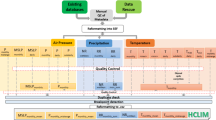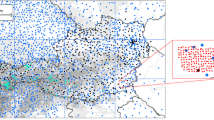Abstract
The procedures involved in constructing data banks for use in climatological research are described, using examples from work done in the Climatic Research Unit. Such data banks will normally have two component parts: the meteorological records themselves, and the accompanying documentary and information systems.
As a first step, meteorological records appropriate for the intended application of the data bank must be collected and stored, commonly in a computer. Individual records must then be merged into a form convenient for the user. For example, all records from one geographical region may be stored in one computer file. Procedures for quality control of the data are discussed. We emphasize the need to ensure that records are homogeneous, i.e., that they do not contain spurious jumps or trends caused by non-climatic factors such as site change or urbanization. Some techniques to correct inhomogeneities in meteorological records are described.
The documentation accompanying the meteorological records enables users of the data bank to assess the suitability and reliability of the data. It has three components: first, information on the individual records such as start year, end year, altitude of the site, and geographical position; second, a list of data sources used in the compilation process; third, station histories which detail any known changes in site, instrumentation, etc. The station histories will be added to as work progresses on the data bank, to describe any attempts to homogenize records, and ultimately to give the compiler's assessment of the reliability of each record.
User needs must be considered at all stages of data bank design and construction. Only in this way will a well-documented and easy-to-use system result.
Similar content being viewed by others
References
Bigelow, F. H.: 1902, ‘Report of the Barometry of the United States, Canada, and the West Indies’, Report of the Chief of the Weather Bureau, 1900–1901, II, Washington, D.C.
Bigelow, F. H.: 1909, ‘Report on the Temperature and Vapor Tensions of the United States’, Bulletin S, Weather Bureau, U.S. Department of Agriculture, Washington, D.C.
Bradley, R. S., P. M. Kelly, P. D. Jones, C. M. Goodess and H. F. Diaz: 1985, ‘A Climatic Data Bank for Northern Hemisphere Land Areas, 1851–1980’, DoE Technical Report No. TR017, U.S. Department of Energy, Carbon Dioxide Research Division, Washington, D.C., 335 pp.
Conrad, V. and L. D. Pollak: 1962, Methods in Climatology, Harvard University Press, Cambridge.
Craddock, J. M.: 1977, ‘A Homogeneous Record of Monthly Rainfall Totals for Norwich for the Years 1836 to 1976’, Meteorological Magazine, 106, 267–278.
Davidson, K.: 1983, ‘Data Management and Associated Typical Problems at the National Climatic Data Center’, Proceedings of the Workshop on Data Management for the Americas, Brasilia, World Climate Data Programme, WCP-57, World Meteorological Organization, Geneva, 202–210.
Goodess, C. M., M. Wigzell and P. M. Kelly: 1984, ‘The Design of a Climatic Data Bank and Information Retrieval System’, Proceedings of the Tenth Northern Libraries Colloquium, Centre for Cold Ocean Resources Engineering (C-CORE), Publication No. 84–19, Memorial University of Newfoundland, St. John's, 89–111.
Hare, F. K.: 1983, ‘Climate and Desertification: A Revised Analysis’, World Climate Applications Programme, WCP-44, World Meteorological Organization, Geneva.
Jenne, R.: 1975, ‘Data Sets for Meteorological Research’, NCAR Technical Note, IA111, National Center for Atmospheric Research, Boulder.
Jones, P. D.: 1980, ‘A Homogeneous Rainfall Record for the Cirencester Area, 1844–1977’, Meteorological Magazine, 109, 249–258.
Jones, P. D.: 1981, ‘A Survey of Rainfall Recording in Two Regions of the Northern Pennines’, Meteorological Magazine, 110, 239–252.
Jones, P. D., T. M. L. Wigley and K. R. Briffa: 1983, ‘Reconstructing Surface Pressure Patterns Using Principal Components Regression on Temperature and Precipitation Data’, Proceedings of the International Meeting on Statistical Climatology, Instituto Nacional de Meteorologia e Geofisica, Lisbon, 4.2.1–4.2.8.
Jones, P. D., S. C. B. Raper, B. Santer, B. S. G. Cherry, C. Goodess, P. M. Kelly, T. M. L. Wigley, R. S. Bradley and H. F. Diaz: 1985, ‘A Grid Point Surface Air Temperature Data Set for the Northern Hemisphere’, DoE Technical Report, No. TR022, U.S. Department of Energy, Carbon Dioxide Research Division, Washington, D.C., 251 pp.
Jones, P. D., S. C. B. Raper, R. S. Bradley, H. F. Diaz, P. M. Kelly, and T. M. L. Wigley: 1986, ‘Northern Hemisphere Surface Air Temperature Variations 1851–1984’, Journal of Climatology and Applied Meteorology, 25, 161–179.
Linsley, R. K. Jr., M. A. Kohler and J. L. M. Paulhus: 1982, Hydrology for Engineers, Third Edition, McGraw-Hill Series in Water Resources and Environmental Engineering, McGraw-Hill.
Mitchell, J. M. Jr.: 1953, ‘On the Causes of Instrumentally Observed Secular Temperature Trends’, Journal of Meteorology, 10, 244–261.
Mitchell, J. M. Jr., B. Dzerdzeevskii, H. Flohn, W. L. Hofmeyr, H. H. Lamb, K. N. Rao, and C. C. Wallen: 1966, ‘Climatic Change’, WMO Technical Note, No. 79, World Meteorological Organization, Geneva.
Palutikof, J. P., T. D. Davies, and P. M. Kelly: 1984, ‘A Databank of Wind Speed Records for the British Isles and Offshore Waters’, in Wind Energy Conversion 1984, Ed. P. Musgrove, Cambridge University Press, Cambridge, 414–425.
Rodda, J. C.: 1971, ‘The Precipitation Measurement Paradox—The Instrument Accuracy Problem’, WMO Reports on WMO/IHD Projects, 16, World Meteorological Organization, Geneva.
Royal Observatory: 1921, Results of the Magnetical and Meteorological Observations Made at the Royal Observatory, Greenwich, in the Year 1916, Her Majesty's Stationery Office, London.
Smith, S. G.: 1981, ‘Comparison of Wind Speeds Recorded by Pressure-Tube and Meteorological Office Electrical Cup Generator Anemographs’, Meteorological Magazine, 110, 288–300.
U.K. Meteorological Office: 1956, Handbook of Meteorological Instruments, Part I: Instruments for Surface Observations, Her Majesty's Stationery Office, London.
WCDP: 1982, ‘Guidelines on Climate Data Organization and Formats’, Prepared by the Inter-Commission Meeting of Experts on Climate Data Organization and Formats, World Climate Data Programme, WCP-31, World Meteorological Organization, Geneva.
Author information
Authors and Affiliations
Rights and permissions
About this article
Cite this article
Palutikof, J.P., Goddess, C.M. The design and use of climatological data banks, with emphasis on the preparation and homogenization of surface monthly records. Climatic Change 9, 129–147 (1986). https://doi.org/10.1007/BF00140532
Issue Date:
DOI: https://doi.org/10.1007/BF00140532




